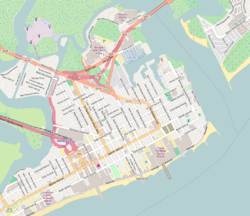Club Harlem

Club Harlem, 1964
|
|
|
Location in Atlantic City
|
|
| Address | 32 Kentucky Avenue Atlantic City, New Jersey United States |
|---|---|
| Coordinates | 39°21′35″N 74°25′47″W / 39.35972°N 74.42972°WCoordinates: 39°21′35″N 74°25′47″W / 39.35972°N 74.42972°W |
| Owner | Leroy "Pop" Williams, Clifton Williams, Ben Alten |
| Type | Nightclub |
| Capacity | 900–1000 |
| Opened | 1935 |
| Closed | 1986 |
Club Harlem was a nightclub at 32 Kentucky Avenue in Atlantic City, New Jersey. Founded in 1935 by Leroy "Pop" Williams, it was the city's premier club for black jazz performers. Like its Harlem counterpart, the Cotton Club, many of Club Harlem's guests were white, wealthy and eager to experience a night of African-American entertainment.
An elaborate all-black revue called "Smart Affairs", produced by Larry Steele and headquartered at the club from 1946 to 1971, featured 40 to 50 acts and was on a par with Broadway productions. Performers at the club included Sammy Davis Jr. (who would also invite the white members of the Rat Pack), Dick Gregory, Dinah Washington, Bootsie Barnes, Gladys Knight, Teddy Pendegrass, Hot Lips Page, and Wild Bill Davis. Drummer Crazy Chris Columbo conducted the club orchestra for 34 years. Club Harlem was outfitted with seven bars, two lounges and a main showroom seating over 900. A cocktail lounge had room for 400 guests with continuous entertainment available.
Club Harlem was the site of the 1972 Easter morning shootout of a Black Mafia operative by three rival operatives, leaving 5 dead and 20 wounded, in full view of a show audience estimated at about 600 people. The club closed in 1986 and was demolished in 1992. Mementos salvaged from the club are part of a traveling exhibition which has appeared in Atlantic City and other locales since 2010.
Club Harlem was founded in 1935 by Leroy "Pop" Williams on the site of a dance hall called Fitzgerald's Auditorium. Williams was a medical student at University of Pennsylvania when he managed to acquire enough money to buy Fitzgerald's; he left college after becoming the owner of the nightclub. Williams gave the new nightclub the name of the Manhattan neighborhood because "a lot of black people live there". The district, known as "Kentucky Avenue and the Curb", had become the home for African-Americans in the racially-segregated city since the end of World War I. The new nightspot joined other popular black entertainment venues in the district such as Grace's Little Belmont, the Wintergarten, and the Paradise Club. Along with Harlem's "Cotton Club", it was a place for the moneyed set to enjoy an evening of African-American entertainment. When the club opened in 1935, there were slot machines along with a basketball court on the top floor of the building. In the 1940s the club became known as Clifton's Club Harlem.
...
Wikipedia

